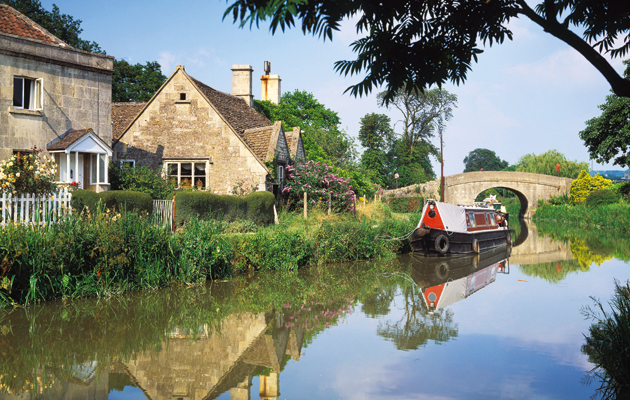Buying a houseboat
Tips on purchasing a floating home.


Seventy years ago, Cressy, the Shropshire Union Canal boat immortalised in Tom Rolt’s elegaic travelogue Narrow Boat, inspired a generation to take to the waterways and discover a Britain untouched since the Industrial Revolution. The book is still in print and, today, canals, once-forgotten relics hidden behind corrugated iron, are home to a floating population of 15,000 that encompasses young professionals, families and retirees.
Boaters can still enjoy the simpler way of life and ever-changing scenery, but, these days, thanks to regeneration initiated by British Waterways (now the Canal & River Trust), canals attract wildlife such as kingfishers, water voles and otters and are vibrant and cultural places on which to live and work.
Life on the water is also eco-friendly and markedly cheaper than living in a house; an average houseboat costs less than £100,000, enabling those selling their home to release some equity and live mortgage-free.
And you don’t have to forgo the comforts of 21st-century living, either: the most luxurious vessels have hot tubs and swimming pools on deck. Boats on fixed moorings can be supplied with broadband, telephone lines, mains electricity and water; those on continuous cruising licences, moving to a new mooring every 14 days, can run washing machines, power showers and plasma televisions via 12v or 240v batteries.
Canals aren’t for everyone. Boats leak, batteries run flat and the water attracts mice and rats. However, those who yearn for a simpler life relish the freedom— and find their boat becomes so much more than just a place to sleep.
Thinkings of buying a houseboat?
- Boaters can choose between a static houseboat or one with an engine that you can move around. A houseboat in good working condition on a mooring can be bought for less than £100,000, although the most luxurious sell for up to £1 million. Visit www.apolloduck.co.uk and www.premierhouseboats.co.uk for listings.
- Mortgages for houseboats from high-street banks can be costly. More reasonable rates can be found by using a specialist marine financier such as RoyScot Larch (www.royscotlarch.co.uk) or Collidge & Partners (www.collidgeandpartners.co.uk). For legal information, visit www.yachtinglawyers.com
- If you intend to use UK canals or rivers, you must obtain a licence from the Canal & River Trust plus a Boat Safety Scheme certificate and third-party insurance to a minimum value of £2 million. There is no licence required to pilot a houseboat, but the Canal & River Trust recommends a boat-handling course by the Royal Yachting Association (www.rya.org.uk). For more information, consult the Residential Boat Owners’ Association (http://rboa.org.uk).
- Moorings are listed on the Canal & River Trust website at www.crtmoorings.com. The Canal & River Trust auctions off 4,000 berths each year and the Environment Agency and Port of London Authority also have moorings. A monthly mooring costs from £70 to £750.
- Fixed or ‘home’ moorings cost from £1,800 a year up to £10,000 depending on the area; continuous cruising licences, which require owners to move to a new berth every 14 days, are about £1,000.
- Fuel, electricity, tax, boat insurance and repair costs must also be factored in to your annual budget.
Sign up for the Country Life Newsletter
Exquisite houses, the beauty of Nature, and how to get the most from your life, straight to your inbox.
Country Life is unlike any other magazine: the only glossy weekly on the newsstand and the only magazine that has been guest-edited by HRH The King not once, but twice. It is a celebration of modern rural life and all its diverse joys and pleasures — that was first published in Queen Victoria's Diamond Jubilee year. Our eclectic mixture of witty and informative content — from the most up-to-date property news and commentary and a coveted glimpse inside some of the UK's best houses and gardens, to gardening, the arts and interior design, written by experts in their field — still cannot be found in print or online, anywhere else.
-
 'Monolithic, multi-layered and quite, quite magnificent. This was love at first bite': Tom Parker Bowles on his lifelong love affair with lasagne
'Monolithic, multi-layered and quite, quite magnificent. This was love at first bite': Tom Parker Bowles on his lifelong love affair with lasagneAn upwardly mobile spaghetti Bolognese, lasagne al forno, with oozing béchamel and layered meaty magnificence, is a bona fide comfort classic, declares Tom Parker Bowles.
By Tom Parker Bowles Published
-
 Country houses, cream teas and Baywatch: Country Life Quiz of the Day, April 24, 2025
Country houses, cream teas and Baywatch: Country Life Quiz of the Day, April 24, 2025Thursday's Quiz of the Day asks exactly how popular Baywatch became.
By Toby Keel Published
